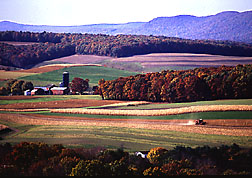Forum—The Long-Term Agroecosystem Network:
Starting Local, Going National
|
|
Farmers know their land. They know where tractors get stuck in boggy spots and how sunlight moves across the fields every day of the year. They know how to time plowing, planting, weeding, fertilizing, and harvesting to maximize the benefits of warm spells, cold snaps, winter squalls, and summer downpours. They watch for the arrival of invasive plants, insect pests, wildlife predators, and the bacteria, viruses, and fungi that create havoc for crops and livestock. And they know that how they manage their crops, animals, livestock waste, water, and soil isn’t just about on-farm profits and sustainability; their actions and decisions can affect air, water, and soil resources far beyond their own fence lines.
But farmers already have their hands full with day-to-day chores and don’t have much time to compare notes and discuss the costs and benefits of their management choices. And they certainly don’t have the time or resources to design research protocols; instrument their fields and barns; collect air, water, and soil samples; and analyze their findings.
That’s where the Agricultural Research Service—and colleagues from almost 200 other federal and state agencies, universities, and other organizations—comes in. On September 10, 2012, ARS officials announced the establishment of the Long-Term Agroecosystem Research (LTAR) network, which builds on its existing experimental watersheds and rangelands nationwide. This network addresses large-scale multi-year research; environmental management testing; and technology transfer related to the nation’s agricultural ecosystems in an assortment of different environments—western rangelands, midwestern prairies, the humid southeast, the temperate Mid-Atlantic—all of which face specific regional issues and challenges linked to agricultural production.
The LTAR network is starting up with 10 sites that are already affiliated with ARS locations. These sites are at Ames, Iowa; Cheyenne, Wyoming; Columbia, Missouri; El Reno, Oklahoma; Las Cruces, New Mexico; Mandan, North Dakota; Pullman, Washington; Tifton, Georgia; Tucson, Arizona; and University Park, Pennsylvania. More locations may be added to the network in the future, including sites that can provide key data about agricultural practices in the lower Mississippi River basin, the lower Chesapeake Bay, Florida, California, and the Great Basin.
The LTAR network will use the combined information gathered at these individual locations to address complex scientific questions about long-term processes operating at regional or national scales that cannot be addressed with data from individual locations alone. Using this approach, LTAR scientists will be able to monitor agricultural issues—such as periodic outbreaks of pests and pathogens, changes in soil carbon levels, global climate change effects, and the impacts of land-use changes—in a diverse assortment of regions and environments. The data collected by LTAR teams can be used to calibrate and validate computer models that forecast how these factors play out in short-term and long-term dynamics.
Information from the LTAR network can also contribute to the development of agricultural production systems that maximize energy conservation and reduce greenhouse gases. Various forms of incentives can be investigated to encourage on-farm adoption and mitigation. These findings can also be used to optimize biodiversity for conserving and protecting natural resources and enhancing agricultural profitability.
ARS scientists working within the LTAR network interact and collaborate with researchers from other national ecological research networks, including the National Science Foundation’s Long-Term Ecological Research and Critical Zone Observatory networks; the National Ecological Observatory Network (NEON), now being developed by the National Science Foundation and NEON, Inc.; and the USDA Forest Service network of experimental forests and ranges.
No matter how much we try to control our choices and manage our boundaries, our agricultural practices will leave an environmental footprint somewhere. This realization is the foundation for our work in the LTAR network. We believe our results will lead to management decisions that leave benign footprints and generate long-term sustainable systems for agricultural productivity—all of which will be essential as we protect natural resources and produce the food, feed, and fiber needed to meet the demands of an ever-expanding global population.
Mark Walbridge
ARS National Program Leader
Water Availability and Watershed Management
"Forum" was published in the September 2013 issue of Agricultural Research magazine.







